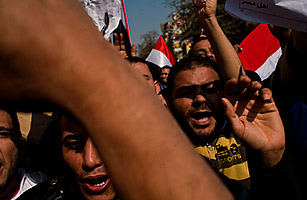
Last week, after the Egyptian opposition called for a march after prayers, TIME’s Abigail Hauslohner, based in Cairo, and TIME’s Rania Abouzeid, who had just returned from covering the Tunisian uprising, walked among the protesters and felt the blunt and brutal response of the regime’s antiriot police. To escape club-bearing cops, Hauslohner ran through narrow streets and found refuge in a small courtyard, only to have a tear-gas canister land near where she stood with a small group of protesters. She clambered up a stairway to the roof and saw cops going door to door and opening fire. Abouzeid took a different route: when a tear-gas canister landed right next to her, one of the protesters handed her a can of soda. “Here,” he said, “put Pepsi on your eyes. It won’t burn as badly.”
Revolutions aren’t pretty. The birth of democracy is never easy. The events of the past two weeks across the Middle East are of world-historic importance, and we are using every resource to cover them. The Egyptian army believes in the maxim that the revolution should not be televised — or photographed. Our two contract photographers, Yuri Kozyrev and Dominic Nahr, were both stopped by Egyptian soldiers. On Monday, Jan. 31, Nahr was photographing at a looted mall and was surrounded at gunpoint by soldiers who took all of his camera’s memory cards. During the Feb. 2 clashes in Tahrir Square, soldiers grabbed Kozyrev; an Egyptian secret policeman opened his camera and confiscated his memory card as well.